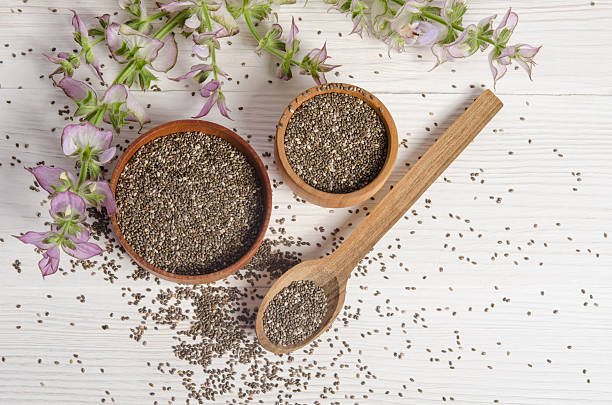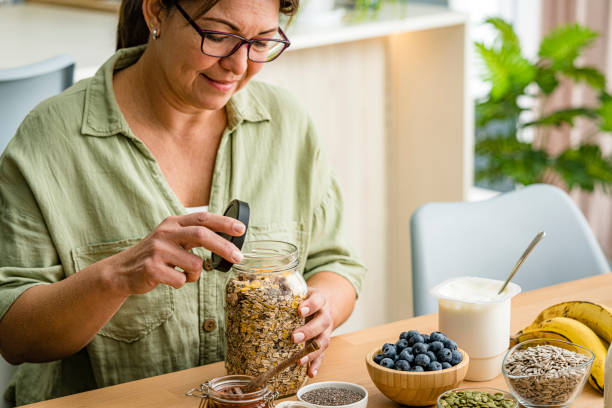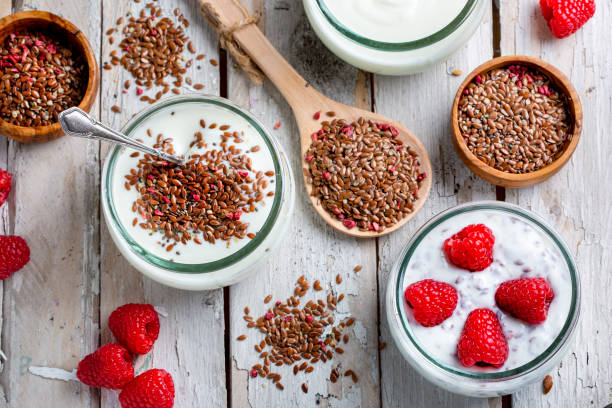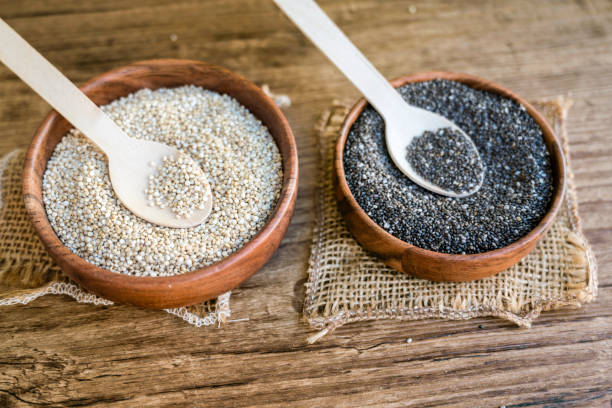Chia Seeds vs Hemp Seeds: A Complete Nutritional Comparison

Introduction to Chia Seeds vs Hemp Seeds
Chia seeds and hemp seeds are two popular superfoods recognized for their impressive nutritional profiles and versatility in culinary applications. Widely appreciated for their health benefits, these seeds have become staples in diets focused on wellness and nutrition. While both are small in size, they pack a significant punch in terms of nutrients, offering distinct advantages for individuals seeking plant-based sources of nourishment.
Chia Seeds
Chia seeds, derived from the Salvia hispanica plant, are native to Central America and have been used as a food source for centuries. Rich in fiber, omega-3 fatty acids, and plant-based protein, chia seeds are often incorporated into breakfast recipes, smoothies, and baked goods. Their ability to absorb liquid expands their size and forms a gel-like texture, making them useful as a thickening agent or egg substitute in vegan cooking. Additionally, chia seeds contain essential minerals such as calcium, magnesium, and phosphorus, contributing to overall bone health.
Hemp Seeds
Hemp seeds, the edible seeds of the Cannabis sativa plant, are another nutrient-dense food option. Contrary to common misconceptions, hemp seeds do not contain psychoactive properties and are perfectly safe for consumption. These seeds are especially known for their high-quality protein content, which includes all nine essential amino acids. Moreover, hemp seeds are rich in omega-6 and omega-3 fatty acids and feature a balanced 3:1 ratio of these fats. Alongside their fat and protein content, they are a source of several minerals, including iron, zinc, and magnesium. Their mild, nutty flavor makes them easy to incorporate into salads, snacks, and smoothies.
Chia seeds and hemp seeds serve complementary roles in enhancing dietary health. While they share similarities such as being excellent sources of nutrients, their differences in composition, flavor profile, and culinary uses set them apart. Understanding these distinctions can help individuals make informed choices based on their nutrition goals and preferences.
Origins and Cultivation Differences: Chia Seeds vs Hemp Seeds

Chia seeds and hemp seeds originate from distinct plants native to different parts of the world, each with its own unique cultivation practices. Chia seeds come from the Salvia hispanica plant, a species of flowering plant in the mint family native to Central and South America. This plant thrives in warm climates and is typically grown in countries like Mexico, Argentina, and Bolivia. It requires well-drained soil and specific weather conditions, including substantial sunlight and adequate water during its growing season.
Hemp seeds, on the other hand, are derived from the Cannabis sativa plant, a versatile crop historically cultivated for multiple purposes, including textiles, oils, and food. Hemp has origins tracing back to Asia and the Middle East, though its cultivation has now spread worldwide. Unlike chia, hemp is a hardy plant that can adapt to various climates, from temperate to subtropical regions, and prefers nutrient-rich, well-drained soil. It also requires less water than chia and benefits from crop rotation practices to maintain soil health.
The cultivation process of chia seeds is often more straightforward, as they typically require minimal intervention once established on the field. These plants grow tall and flower before the seeds are harvested. Conversely, hemp requires more attentive management, especially regarding legal regulations, as it is closely related to the controversial marijuana plant, although hemp contains negligible amounts of THC.
Another key difference lies in harvesting. Chia seeds are delicate and can be harvested using simpler methods due to their small size and uniform growth. In comparison, hemp seeds are more labor-intensive to harvest, as the plant produces seeds alongside fibrous stalks, which may require specialized equipment to separate. These differences underscore the unique agricultural characteristics that shape the availability and production of these two nutrient-rich seeds.
Macronutrient Breakdown: Protein, Fats, and Carbohydrates
Chia seeds and hemp seeds, both celebrated for their nutritional value, provide an excellent balance of macronutrients, each with unique characteristics. Understanding their macronutrient profiles offers insight into their potential roles in diet planning.
Protein Content
Hemp seeds are notably higher in protein compared to chia seeds, making them particularly appealing for individuals seeking plant-based protein sources. A 28-gram serving (about 2 tablespoons) of hemp seeds provides approximately 9.5 grams of protein. This protein is of high quality due to its complete amino acid profile, including all nine essential amino acids. Chia seeds, by contrast, offer around 4.7 grams of protein per 28-gram serving. While lower in total protein, chia seeds still contribute a substantial amount, particularly for vegetarian or vegan diets.
Fat Composition
Hemp seeds are rich in healthy fats, offering around 14 grams of fat per serving. Notably, this fat content includes omega-6 and omega-3 fatty acids in an ideal ratio of 3:1 for optimal health benefits, supporting heart health and reducing inflammation. Meanwhile, chia seeds contain approximately 9 grams of fat per serving. Chia seeds are particularly high in alpha-linolenic acid (ALA), a plant-based omega-3 that supports brain and heart health.
Carbohydrate Profile
When it comes to carbohydrates, chia seeds are the dominant source, providing 12 grams per serving, of which 10 grams come from fiber. The high fiber content makes chia seeds a key player in improving digestive health and promoting satiety. Hemp seeds, on the other hand, are lower in carbohydrates, offering just about 2 grams per serving, with 1 gram coming from fiber, making them suitable for low-carb diets.
By examining these macronutrient differences, it is evident that both seeds cater to specific dietary needs and preferences.
Omega-3 and Omega-6 Fatty Acids: A Close Comparison
Chia seeds and hemp seeds are rich sources of essential fatty acids, but they differ significantly in their omega-3 and omega-6 fatty acid profiles. These two types of polyunsaturated fats are crucial for numerous biological functions, including brain health, inflammation regulation, and cellular structure. However, maintaining a proper balance between omega-3 and omega-6 consumption is vital to reap their health benefits fully.
Chia seeds are especially known for their high omega-3 fatty acid content, primarily in the form of alpha-linolenic acid (ALA). One ounce of chia seeds contains approximately 5,000 milligrams of omega-3 fats. This makes them an excellent plant-based source for individuals looking to support cardiovascular health, reduce inflammation, and promote cognitive function. Importantly, the omega-6 content in chia seeds is relatively low, creating an inherently favorable omega-3 to omega-6 ratio.
Hemp seeds, in contrast, offer a different fatty acid profile. They provide a more balanced ratio of omega-3 to omega-6 fatty acids, with a particularly high level of omega-6 fats, including gamma-linolenic acid (GLA). One ounce of hemp seeds contains around 10,000 milligrams of omega-6 fatty acids and about 3,000 milligrams of omega-3s. This ratio caters to general cellular health, proper immune function, and hormonal regulation. The inclusion of GLA adds anti-inflammatory properties not commonly found in plant-based foods.
The divergent fatty acid compositions of chia and hemp seeds make them complementary rather than interchangeable. Individuals focusing on enhancing omega-3 intake may benefit more from chia seeds, while those aiming to maintain a balanced omega-3 to omega-6 ratio could consider incorporating hemp seeds into their diets. Both seeds present valuable options for meeting essential fatty acid requirements through plant-based nutrition.
Vitamins and Minerals: Nutrient Density Analysis

Chia seeds and hemp seeds are notable for their impressive profiles of vitamins and minerals, making them valuable additions to a balanced diet. Both superfoods exhibit a range of micronutrients essential for maintaining health, yet their nutrient compositions differ in significant ways.
Chia seeds are particularly rich in calcium, making them a favorable choice for bone health. A single ounce of chia seeds contains approximately 18% of the daily recommended intake of calcium. Additionally, they provide magnesium, phosphorus, and potassium, which contribute to the body’s enzymatic functions, nerve signaling, and muscle contraction. Chia seeds also contain small amounts of zinc, a mineral essential for immune function, and manganese, which plays a role in metabolism and antioxidant defenses. Moreover, their high selenium content supports cellular protection against oxidative damage.
Hemp seeds, on the other hand, are notably rich in magnesium, exceeding the magnesium content found in chia seeds. Magnesium in hemp seeds supports cardiovascular health, energy production, and nerve function. Hemp seeds are also an excellent source of phosphorus and iron, with one ounce providing over 20% of the daily recommended intake for iron, contributing to oxygen transport in the blood. Zinc content in hemp seeds is slightly higher than that in chia seeds, boosting their role in skin repair, immune support, and wound healing. Additionally, hemp seeds deliver significant folate levels, an important B-vitamin for DNA synthesis and red blood cell production.
While chia seeds stand out for their calcium and selenium concentrations, hemp seeds excel in magnesium, iron, and folate content. Both seeds contain vitamin E, a powerful antioxidant that protects cell membranes from free radical damage. Including a variety of these seeds in one’s diet can optimize micronutrient intake. Each seed type boasts unique strengths, making them complementary offerings in nutrient-rich diets.
Dietary Fiber Content and Its Health Impacts
Chia seeds and hemp seeds both serve as valuable sources of dietary fiber, an essential nutrient for supporting digestive health and overall well-being. However, their fiber content varies significantly, which can influence their suitability for specific dietary needs.
Chia seeds are particularly rich in dietary fiber, offering approximately 10-11 grams of fiber per ounce (28 grams). Nearly all the carbohydrates in chia seeds come from fiber, making them an excellent choice for those aiming to manage blood sugar levels or maintain a low-carb diet. The fiber in chia seeds is predominantly insoluble, forming a gel-like texture when mixed with water. This unique characteristic contributes to a slower digestion process, promoting feelings of fullness and aiding in weight management.
Hemp seeds, on the other hand, contain a comparatively modest amount of fiber, with about 1 gram per ounce. While this level is significantly lower than that of chia seeds, hemp seeds still provide nutritional benefits through their combination of soluble and insoluble fibers. Soluble fiber in hemp seeds can help support beneficial gut bacteria, while insoluble fiber aids in promoting digestive regularity.
The high fiber content in chia seeds allows them to play a more prominent role in reducing cholesterol levels, stabilizing blood sugar, and improving cardiovascular health. In contrast, the fiber content in hemp seeds, though lower, still offers digestive support and a minor contribution to dietary fiber intake when consumed alongside other fiber-rich foods.
Both seeds can complement a balanced diet, but chia seeds may be particularly advantageous for individuals targeting higher fiber consumption. Comparing the fiber content helps clarify their nutritional distinctiveness and aligns them with specific health goals and dietary preferences.
Antioxidants and Unique Phytonutrients in Each Seed

Chia seeds and hemp seeds both deliver a range of antioxidants and phytonutrients that contribute to their respective nutritional benefits, yet the types and concentrations can vary significantly between the two.
Chia seeds are particularly notable for their robust antioxidant profile. They are rich in compounds such as chlorogenic acid, caffeic acid, myricetin, and quercetin. These antioxidants help to mitigate oxidative stress and neutralize free radicals, potentially lowering the risk of chronic diseases such as cardiovascular disorders and certain types of cancer. Moreover, the antioxidants found in chia seeds also play a crucial role in preserving the natural oils within the seeds, contributing to their long shelf life and stable nutritive properties.
Hemp seeds, on the other hand, possess phytonutrients that uniquely complement their fatty acid richness. They contain tocopherols, a form of vitamin E, which exhibit potent antioxidant activity. This can support skin health, reduce inflammation, and protect cells from oxidative damage. Additionally, hemp seeds include small amounts of phytosterols, plant-based compounds known to support heart health by contributing to cholesterol reduction.
While chia seeds excel in polyphenols, hemp seeds distinguish themselves through their gamma-linolenic acid (GLA) content. Though technically classified as a fatty acid, GLA has antioxidant effects and anti-inflammatory properties that amplify the health benefits of hemp seeds. The combination of omega fatty acids and antioxidants in hemp seeds particularly supports metabolic health and cellular function.
Together, the antioxidant profiles highlight the functional value of both seeds, though their unique phytonutrients provide distinct health advantages. Differences in nutrient concentration and focus reveal how they serve complementary purposes in a balanced diet.
Health Benefits and Potential Uses in Diets
Chia seeds and hemp seeds both offer a wide array of health benefits, making them versatile additions to various dietary routines. While chia seeds are predominantly known for their high omega-3 fatty acid content, hemp seeds are celebrated for their excellent balance of omega-3 and omega-6 fatty acids, crucial for supporting heart health and reducing inflammation. These plant-based seeds also complement diets targeting specific nutritional goals or catering to certain health conditions.
Health Benefits of Chia Seeds:
- Rich in Antioxidants: Chia seeds contain antioxidant compounds that help combat oxidative stress, potentially reducing the risk of chronic diseases such as diabetes and certain cancers.
- High Fiber Content: A single ounce of chia seeds provides roughly 10 grams of fiber, aiding digestion and supporting healthy cholesterol levels while promoting a feeling of fullness—useful for weight management.
- Bone Health: Chia seeds are a source of calcium, phosphorus, and magnesium, all essential minerals for maintaining strong bones and proper nerve function.
- Steady Energy Release: Their ability to absorb water creates a gel-like consistency when mixed with liquids, slowing digestion and providing sustained energy release.
Health Benefits of Hemp Seeds:
- High Protein Content: Hemp seeds are an exceptional source of plant-based protein, containing all nine essential amino acids critical for muscle repair and overall body function.
- Essential Fatty Acids: With a near-ideal 3:1 ratio of omega-6 to omega-3 fatty acids, hemp seeds contribute to brain health, immune system function, and hormonal regulation.
- Rich in Magnesium: Hemp seeds support heart health by delivering magnesium, a mineral essential for proper muscle and nerve function, alongside potassium for blood pressure regulation.
- Vitamin E Benefits: The presence of vitamin E helps boost skin health, along with its antioxidant properties that protect cells from damage.
Potential Uses in Diets:
- Chia Seeds: They can be integrated into smoothies, oatmeal, and yogurt as thickening agents, or used as egg substitutes in vegan recipes when mixed with water. Adding them to baked goods or sprinkling them over salads enhances texture and nutritional value.
- Hemp Seeds: Because of their nutty flavor, hemp seeds pair well with salads, soups, and stir-fries. They blend effortlessly into protein shakes, energy bars, and homemade granola. Their natural creaminess makes them suitable for vegan milk or butter alternatives.
Both seeds can be valuable components of keto, vegetarian, and vegan diets, while their nutrient profiles align with the dietary requirements of individuals seeking heart and digestive health improvements. Their versatility ensures easy inclusion in meal planning for diverse culinary preferences.
where to buy Chia Seeds and Hemp Seeds
After trying several options, these are the chia and hemp seed products I personally recommend based on quality, freshness, and overall nutritional value.
Best Organic Chia Seeds
Navitas Organics Chia Seeds
These are certified organic, non-GMO, and have a mild flavor that blends seamlessly into smoothies, oatmeal, or baking. They absorb liquid well, forming a gel-like texture that’s great for digestion and helps keep me full longer.
Check on Amazon
Best Hemp Seeds for Nutrition
Nutiva Organic Hemp Seed Hearts
Nutiva’s hemp seeds are rich in plant-based protein and omega-3s. I like adding them to salads, yogurt, or smoothie bowls. They have a soft texture and a subtle nutty taste, making them easy to incorporate daily.
View on Amazon
Best Chia and Hemp Blend
Anthony’s Organic Chia & Hemp Seeds Mix
This blend combines the benefits of both seeds in one bag. It’s convenient for topping breakfast bowls or baking healthy snacks without needing two separate products.
Try it here
Culinary Applications and Versatility of Chia Seeds and Hemp Seeds

Chia seeds and hemp seeds are exceptionally versatile in culinary applications, lending themselves to a variety of recipes and preparation methods. With their distinct textures and flavor profiles, they can enhance both the nutritional content and taste of meals. Each seed type has unique properties that make them suitable for specific cooking and baking purposes.
Usage of Chia Seeds
Chia seeds, known for their ability to absorb liquid, are often used as a thickening agent in recipes. When soaked in water or other liquids, they form a gel-like consistency, making them ideal for puddings, smoothies, and sauces. Their mild flavor enables them to blend seamlessly with both sweet and savory dishes. Chia seeds are often added to baked goods such as muffins, bread, and cookies to boost fiber and omega-3 fatty acid content. Additionally, they can act as an egg substitute in vegan recipes due to their binding properties. Sprinkling raw chia seeds onto yogurt, oatmeal, or salads provides a nutritional boost without altering the dish’s texture significantly.
Usage of Hemp Seeds
Hemp seeds, on the other hand, have a softer texture and a nutty, earthy flavor that complements a wide range of dishes. They are frequently used as a topping for salads, smoothie bowls, and stir-fried vegetables, adding both crunch and protein. Unlike chia seeds, hemp seeds can be eaten raw without the need for soaking or preparation, making them an effortless addition to meals. Their creamy consistency when blended makes them suitable for dairy-free milk alternatives and nutrient-rich protein shakes. Hemp seeds can also be incorporated into granola bars, dips, spreads, or even made into hemp butter, providing versatility across cuisines.
Comparisons in Cooking
While chia seeds excel in recipes requiring thickening or binding, hemp seeds are preferred for their rich, nutty flavor and protein content. Chia seeds are often chosen for texture improvement in desserts, whereas hemp seeds are favored for savory applications or recipes demanding a protein boost. Both seeds complement plant-based diets and are highly adaptable ingredients in modern cooking.
The ability to cater to different dietary needs and culinary preferences makes chia seeds and hemp seeds invaluable in kitchen experimentation, encouraging creative and nutritious cooking endeavors.
Sustainability and Environmental Impact of Production
Both chia and hemp seeds are renowned for their nutritional profiles, but their production processes have differing implications for environmental sustainability. Key factors include water usage, soil health, carbon emissions, and overall cultivation practices. Understanding these aspects reveals how each crop contributes to—or mitigates—its environmental footprint.
Water Usage
Chia seeds stand out for their minimal water requirements during cultivation. They are typically grown in arid regions where they thrive without the need for extensive irrigation systems. Conversely, hemp plants require moderate amounts of water, although their water needs are still considerably lower compared to many conventional crops like almonds or avocados.
Soil Health
Hemp cultivation promotes soil health through its ability to remediate soil, a process known as phytoremediation. Hemp effectively absorbs toxins and heavy metals from the soil, enhancing agricultural land quality. Chia plants, on the other hand, primarily contribute to soil stability due to their deep root system, which prevents erosion and promotes water retention. Neither crop demands the use of harmful synthetic fertilizers, making each a favorable option for regenerative farming.
Carbon Emissions
Hemp plants exhibit a remarkable capacity to sequester carbon dioxide, serving as a natural carbon sink. This characteristic positions hemp as an especially eco-friendly crop in combating climate change. Chia cultivation, while less effective in carbon sequestration, benefits from lower greenhouse gas emissions linked to its streamlined growth and harvesting processes.
Land Use and Ecosystem Impact
Chia seeds are cultivated primarily in smaller regions across Central and South America, with limited disruption to local ecosystems due to low-demand farming practices. Hemp requires more extensive land use but compensates by being faster-growing and versatile, supporting diverse industries such as textiles and bioplastics, which reduce dependency on fossil fuels.
In summary, different aspects of sustainability—ranging from water conservation to carbon sequestration—highlight the ecological benefits of both chia and hemp seeds. Their cultivation aligns with broader efforts to achieve sustainable agricultural practices.
Potential Allergens and Safety Concerns
When comparing chia seeds and hemp seeds, it is essential to consider potential allergens and safety concerns, particularly for individuals with specific medical conditions or sensitivities. Both seeds offer a range of health benefits but may pose risks to certain individuals.
Chia Seeds: Allergen Risks and Precautions
Chia seeds are generally recognized as safe for most individuals; however, allergic reactions, though rare, have been reported. Symptoms may include itching, hives, difficulty breathing, or gastrointestinal distress. Individuals with a history of seed or nut allergies should exercise caution when introducing chia seeds into their diet. Additionally, chia seeds are highly absorbent and expand significantly when exposed to liquid, leading to potential choking hazards if consumed dry without proper hydration. Consuming excessive quantities of chia seeds may also cause bloating, gas, or discomfort due to their high fiber content. Those with digestive disorders or sensitive gastrointestinal systems should monitor their intake carefully.
Hemp Seeds: Allergen Risks and Interactions
Hemp seeds are also considered low-risk for serious allergic reactions. However, individuals allergic to cannabis or sensitivities to related plants in the Cannabaceae family may experience adverse effects. Symptoms of hemp seed allergy are mild in most cases but can include skin irritation, throat swelling, or digestive discomfort. Although hemp seeds contain negligible THC, the psychoactive compound in cannabis, there is a theoretical risk of trace THC levels causing issues for individuals undergoing drug testing. Moreover, their omega-3 and omega-6 fatty acid content may interact with anticoagulant medications, potentially increasing the risk of bleeding.
Final Considerations for Safety
Both chia and hemp seeds should be stored properly in cool, dry environments to prevent spoilage. It is advisable to consult a healthcare provider before incorporating these seeds into the diet, particularly for individuals with allergies, medical conditions, or those taking medications with potential dietary interactions.
Cost, Accessibility, and Storage Considerations
When comparing chia seeds and hemp seeds, several factors must be weighed regarding cost, availability, and storage requirements. Both seeds have gained global popularity due to their nutritional benefits, which has influenced their pricing and accessibility in different regions.
Cost
Hemp seeds tend to be more expensive than chia seeds due to the processes involved in their cultivation, harvesting, and processing. The price disparity also reflects hemp’s legal regulations and import fees in certain countries where cultivation is prohibited or restricted. In contrast, chia seeds, often sourced from Central and South America, are generally less costly due to their simpler processing methods and widespread availability in the global health food market. However, regional pricing variations may occur based on local supply and demand dynamics.
Accessibility
Chia seeds are widely available in supermarkets, health food stores, and online retailers worldwide, owing to their broad consumer appeal. Their longer shelf life also facilitates global distribution without significant loss in quality. Hemp seeds, while increasingly common, may encounter accessibility restrictions in countries with stricter laws governing hemp usage. Additionally, although unprocessed hemp seeds are widely permissible, some regions impose limitations on the sale of hemp-derived products like hemp protein powder or oil.
Storage Considerations
Chia seeds are highly durable, with a shelf life of up to two years when stored in a cool, dry place. Their high antioxidant content contributes to their natural resistance to spoilage. On the other hand, hemp seeds are more perishable due to their higher fat content, particularly their abundance of unsaturated fatty acids. They often require refrigeration after opening to prevent rancidity. Properly sealed packaging for both seeds is essential to maintain freshness and nutritional quality over time.
Choosing the Right Seed for Your Needs: Chia vs Hemp

When deciding between chia and hemp seeds, understanding their unique characteristics and nutritional profiles is essential for aligning them with individual health goals and preferences. Both seeds offer unique benefits, but they cater to different dietary and lifestyle needs.
Protein Content and Type Hemp seeds are a superior source of complete protein, providing all nine essential amino acids. This makes them highly suitable for individuals seeking plant-based protein, such as athletes or those on vegetarian or vegan diets. On the other hand, chia seeds contain protein but in lower amounts, making them less ideal as a protein staple compared to hemp.
Omega-3 Fatty Acids Chia seeds are exceptionally high in omega-3 fatty acids, especially alpha-linolenic acid (ALA), which supports heart health and inflammation control. Hemp seeds, while containing omega-3s, are more balanced with omega-6 fatty acids, including gamma-linolenic acid (GLA), known to aid in hormonal regulation and skin health. Those prioritizing omega-3s may lean toward chia, whereas individuals needing a balanced essential fatty acid ratio might prefer hemp.
Dietary Fiber For those aiming to boost fiber intake, chia seeds are the better choice. They contain significantly higher amounts of soluble and insoluble fiber, promoting digestive health and prolonged satiety. Hemp seeds, by contrast, have lower fiber levels but compensate with an impressive nutritional density in other areas.
Caloric Considerations Chia seeds are lower in calories per serving, which benefits calorie-conscious individuals. Conversely, hemp seeds contain more calories, primarily due to their higher fat and protein content, making them a better choice for energy-dense diets.
By comparing these attributes, one can choose chia seeds for digestive health and omega-3 boost, or hemp seeds for protein needs and balanced fats.
Final Thoughts: A Balanced Comparison of Nutritional Value
Chia seeds and hemp seeds each have unique nutritional profiles, and their benefits are tailored to differing dietary needs. Chia seeds are recognized for their significant fiber content, playing a major role in supporting digestive health and promoting feelings of fullness. They offer a rich source of omega-3 fatty acids, specifically alpha-linolenic acid (ALA), contributing positively to heart health and inflammatory regulation. In addition, their antioxidant properties help combat oxidative stress, offering potential long-term benefits for overall well-being.
On the other hand, hemp seeds excel in their protein content, boasting a complete range of essential amino acids rarely found in plant-based foods. Their protein is also highly digestible, making it ideal for individuals seeking plant-based protein alternatives. Hemp seeds are notable for their balanced ratio of omega-3 and omega-6 fatty acids, particularly the presence of gamma-linolenic acid (GLA), which aids in reducing inflammation and supporting hormonal balance. Their abundant supply of magnesium, iron, and zinc further reinforces their value as a nutrient-dense option.
When comparing their energy contributions, chia seeds have a slightly higher caloric density per serving, often driven by their lipid content. Meanwhile, hemp seeds provide higher levels of healthy fats, which are easily absorbed and utilized by the body. For those managing macronutrients or calorie consumption, these differences may influence personal preferences.
Both seeds are versatile in culinary applications and can enhance various meals, from smoothies and salads to baked goods and yogurts. They cater to diverse dietary considerations such as vegan, vegetarian, or paleo lifestyles. Ultimately, the choice between chia seeds and hemp seeds depends on individual health goals and priorities, as both offer distinctive advantages that contribute to nutritional well-being.
